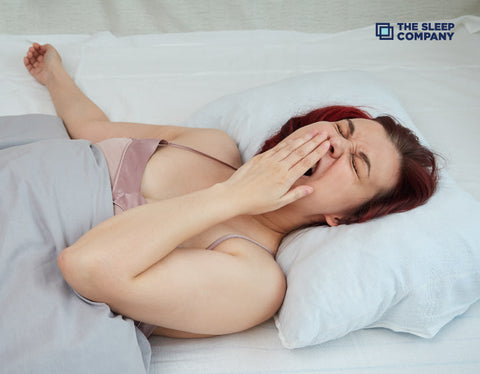My Cart

How Sleeping Position Affects Your Baby’s Growth and Development

Did you know? Your baby's sleeping position affects the pattern of early motor development. Prone sleepers attain several motor milestones earlier than supine sleepers. But sleeping on the back is safer. It can vastly reduce the risks of Sudden Infant Death Syndrome (SIDS).
While each position has its pros and cons, you must understand them better to ensure your baby's healthy growth. From muscle strength to cognitive development, the way your baby sleeps influences more than just comfort.
In today's article, we unpack all you need to know about sleeping positions and how they affect your baby's growth and development. So, let's dive right in!
Common Baby Sleeping Positions and Their Effects
Here’s an overview of the common baby sleeping positions and their effects.
1. Back Sleeping or Supine Position
Back sleeping is said to be one of the best sleep positions for babies. As mentioned earlier, back sleeping can greatly reduce the risk of SIDS. Also, this position helps maintain healthy spinal alignment and curbs the chances of airway obstruction.
However, continuously sleeping on the back may not be ideal for an infant as it can contribute to flat head syndrome (plagiocephaly). That's why parents can encourage tummy time during the day to strengthen neck and shoulder muscles.
2. Side Sleeping
Side sleeping is generally discouraged because babies have very limited control over their movements. So, this can be an unstable and even potentially hazardous sleep position.
For one, there's the risk of rolling onto the stomach, which increases the risks of SIDS. Second, the position can lead to uneven pressure on the head and may cause asymmetrical skull development.
If you see your baby rolling onto the side, it is important that you reposition them on their back. Side sleeping is not recommended for babies under 6 months.
3. Stomach Sleeping or Prone Position
Sleeping on the stomach develops stronger neck, shoulder, and upper body muscles more quickly. That said, his position also significantly increases the risk of SIDS. Why? Because this position increases the chances of suffocation and can restrict airflow.
Also, if a baby sleeps on their stomach, it rebreathes exhaled air and this can put them at risk of oxygen deprivation. There are babies who may find this the comfiest position. But, it is not for younger children.
How Does Sleeping Position Affect Physical Development?

Let’s dig deeper and understand more below!
-
Skull Development & Flat Head Syndrome
An infant's skull is soft and malleable. So, when pressure is exerted on an area for long hours, it leads to flat head syndrome, or positional plagiocephaly, which is when a baby’s head develops a flat spot due to prolonged pressure on one area. That's why to prevent this, parents must change positions during sleep and provide supervised upright time for even skull development.
-
Posture and Spinal Alignment
Your baby's sleep position is directly co-related to spinal alignment and posture. For instance, with back sleeping, the natural curve of the spine is supported and it reduces stress on developing bones. Whereas with side sleeping, there can be uneven pressure and stomach sleeping can strain the neck and back.
A healthy posture is essential from a young age as it can reduce the risks of musculoskeletal issues as the baby grows.
-
Muscle Development and Strength
Stomach sleeping is known to strengthen neck, shoulder, and upper body muscles. This helps babies achieve milestones sooner, like rolling and crawling.
But as it is not the safest option, tummy time during awake hours is a safer alternative. Therefore, a balance of safe sleep positions is the best way forward.
-
Breathing and Lung Expansion
Sleep positions affect breathing in a baby. With back sleeping, the airways remain open, and it reduces the risks of suffocation. Whereas, sleeping on the stomach does the opposite. Side sleeping may also obstruct airways and may not be the best choice.
That's why a proper sleep position is crucial for better oxygen intake. This is essential for brain development, overall health, and reducing respiratory complications in infants.
-
Digestion and Reflux Prevention
For babies with reflux, sleeping on the back is generally safe. Here, side sleeping is unstable, and while stomach sleeping may reduce reflux, it poses significant risks.
So, it is crucial to burp your little one after every feed and keep them upright before they go to bed. This can help with digestion.
-
Circulation and Blood Flow
Sleeping on the back ensures even blood flow and reduces the strain on the heart and extremities. That's not all. It supports healthy oxygen and nutrient delivery. But that's not the case with stomach or side sleeping.
A good sleep position not only keeps your baby safe but promotes overall growth and development.
-
Motor Skill Development
As mentioned earlier, stomach sleeping is excellent for early motor development as it makes the neck, shoulder, and upper body muscles stronger.
However, since prone sleeping increases SIDS risk, tummy time can be better during awake hours. Back sleeping is safest but may slightly delay some motor skills.
Sleep Position and Brain Development
Your baby's sleep position is also connected to their brain development as it influences oxygen intake, sensory stimulation, and motor skill progression.
Sleeping on the back can be an excellent choice because it maintains proper oxygen flow. It also supports cognitive growth and reduces SIDS risk.
Moving on to side sleeping. This sleep position may be unstable for infants. It increases the risk of rolling onto the stomach and affecting even skull development.
Stomach sleeping can restrict airflow and can adversely affect brain development.
Remember, a combination of safe sleep practices and active play enhances overall brain development.
Safety Considerations and Sudden Infant Death Syndrome (SIDS) Prevention
Here are a few things to ensure to prevent SIDS.
- Make sure your baby sleeps on their back as it is the safest position and reduces the risks of SIDS.
- Go for a firm mattress with fitted sheets. Remember, no soft bedding, pillows, or stuffed toys in the crib as they can block airflow and pose dangers.
- Always keep the crib empty. No blankets, bumpers, or loose items that could cause suffocation.
- Keep the baby’s crib near your bed for safety without bed-sharing to avoid any risks.
- Maintain a comfortable room temperature. Avoid overheating, and dress your baby in light sleepwear.
- Encourage tummy time when awake as it helps with muscle development while keeping sleep safe.
Tips for Encouraging a Safe and Comfortable Sleeping Position

Here are a few tips that can help you create a safe sleep environment for your little one.
Back sleeping always
Now you know sleeping on the back is best for your little one. It is safe and reduces the risks of SIDS. Even if your baby rolls over, make sure you reposition them on the back. This way, they enjoy a sound sleep and breathe easily through the night.
Firm, flat mattress
A soft mattress sounds comfortable to us. But that's not what your baby needs. Here, the baby's face can sink in and make it difficult to breathe.
A firm and flat mattress provides essential support and reduces suffocation risks. It even promotes healthy spinal alignment and lets your baby sleep in a safe position throughout the night.
Also, choose a crib mattress that meets safety standards and fits snugly within the crib.
No loose bedding
Loose bedding can interfere with airflow. That's why fitted sheets are your best option.
Also, avoid blankets, pillows, stuffed toys, and crib bumpers as they pose the risk of suffocation. Always keep the crib empty as it helps create a safer sleep environment.
Comfortable room temperature
The room temperature for your little one should be around 68–72°F (20–22°C) to prevent overheating. Since overheating is linked to SIDS, you must be extra careful.
Also, be sure to dress your baby in light and breathable sleepwear. Avoid heavy blankets and ensure proper ventilation.
Daily tummy time
As you read earlier, sleeping on the stomach is good for your child but also poses risks. That's why you should encourage tummy time during awake hours to strengthen your baby’s neck, shoulder, and core muscles.
This way, you prevent flat head syndrome and support motor skill development. Start with a few minutes and gradually increase the time as your little one grows.
Swaddle for security
Swaddling can mimic the snugness babies experience in the womb. It is perfect for infants and also reduces startle reflexes that can disrupt sleep.
But make sure you do it right as making it too tight around the hips can lead to hip dysplasia. Also, use a breathable and lightweight swaddle.
The Final Note
Now you know that sleeping on the back is best for your baby. It is a position that prevents the risks of SIDS and aids overall health and development. While the other positions have their benefits, they also come with risks that just aren't worth it.
Also, make sure you create a safe and comfortable sleep environment for your baby with a firm mattress.
At The Sleep Company, we know that your little one means the world to you. So, we bring you the Smart Baby Mattress that's scientifically designed for growing spines.
Our Smart Baby Mattress offers expert-recommended firmness as per the American Academy of Pediatrics. It ensures your baby gets the right support for better spinal alignment and bone health while offering the comfiest sleep. The mattress is highly breathable and 100% waterproof. So, you don't have to worry about a thing.
Give your baby the safest and the best sleep with the Smart Baby Mattress today!
FAQs
Yes definitely! Sleeping position affects your baby's growth. It aids spinal alignment, muscle development, breathing, and skull shape. We bring you all the information in the above article. Take a look!
Stomach sleeping is not good for your baby as it increases the risk of SIDS, breathing issues, and restricts movement. Sleeping on the back is the safest choice.
A good night's rest supports brain growth, memory, immunity, physical development, and emotional regulation. Proper sleep is essential for a baby’s overall health and well-being.
A 5-10-15 rule for baby sleep is a sleep training method where parents gradually increase wait times before comforting a crying baby.

































































